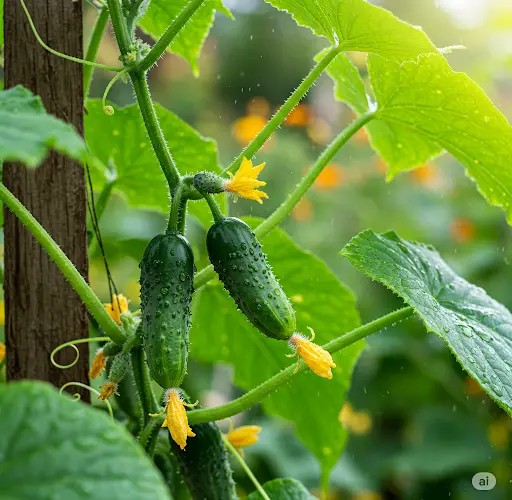Cucumbers are a favorite summer crop for good reason—they’re crisp, refreshing, and easy to grow. But while many gardeners get a decent yield, only a few know how to consistently produce basketfuls of cucumbers from just a few plants. If you want to double your cucumber harvest without doubling your work, it all comes down to a few key strategies.
These five simple secrets, based on sound gardening practices, will help you boost cucumber production naturally and efficiently.
1. Start with the Right Variety
The first and often most overlooked step is choosing the right type of cucumber. Not all cucumbers perform equally, and selecting a high-yielding, disease-resistant variety suited to your climate makes a significant difference.
-
Vining cucumbers generally produce more than bush types. They’re best grown vertically to save space and improve air circulation.
-
Hybrid varieties bred for resistance to diseases like powdery mildew or cucumber mosaic virus can stay productive longer.
-
Some varieties are parthenocarpic, meaning they don’t need pollination to produce fruit—ideal for greenhouse or container gardening.
Look for productive types such as Marketmore, Diva, Straight Eight, or Armenian cucumbers depending on your growing region.
2. Feed the Soil Before the Plant
Cucumbers are heavy feeders and need fertile, well-drained soil rich in organic matter. To set them up for success, prepare your beds weeks before planting.
-
Mix aged compost or well-rotted manure into the soil to boost fertility.
-
A balanced fertilizer with a ratio like 5-10-10 (low nitrogen, higher phosphorus and potassium) encourages strong roots and abundant fruiting.
-
Consider adding a handful of wood ash or banana peel powder for extra potassium, which helps with fruit development.
Keep in mind that overly rich nitrogen soil promotes leaf growth over fruit, so balance is key.
3. Train Cucumbers Vertically
One of the easiest ways to improve cucumber yields is to grow them vertically on a trellis, fence, or netting system.
Why does this work?
-
Improved airflow reduces disease risk.
-
Fruits are easier to find and harvest.
-
Leaves and vines receive more sunlight, boosting photosynthesis and energy production.
-
Fruits are less likely to rot compared to those resting on moist soil.
Start training the vines when they are young, gently tying them to support structures. This also prevents overcrowding, which can reduce fruit quality and lead to pest issues.
4. Water Consistently—and Mulch Well
Cucumbers require regular and consistent moisture to grow plump, tender fruits. Inconsistent watering can lead to bitterness or misshapen cucumbers.
-
Water deeply 2–3 times per week, depending on temperature and rainfall.
-
Drip irrigation or a soaker hose is ideal for delivering water directly to the roots without wetting the foliage.
-
Avoid overwatering, which can lead to root rot.
Apply a thick layer of mulch—such as straw, grass clippings, or shredded leaves—around your plants to:
-
Retain soil moisture
-
Regulate soil temperature
-
Suppress weeds
-
Protect shallow roots
Healthy, stress-free cucumber plants produce significantly more fruit.
5. Harvest Early and Often
One of the most important yet often ignored practices is regular harvesting. Cucumber plants are more productive when their fruits are picked frequently.
-
Leaving mature cucumbers on the vine signals the plant to slow down or stop producing new ones.
-
Harvest cucumbers every 1–2 days during peak season.
-
Use clean scissors or pruners to avoid damaging vines.
Pick cucumbers when they’re firm, uniformly green (or yellow for specific varieties), and before they become overgrown or bitter. Frequent harvesting not only increases total yield but improves fruit quality and appearance.
Bonus Tips for an Even Bigger Harvest
-
Pollination support: For outdoor cucumbers that require pollination, plant flowers nearby to attract bees. Poor pollination can result in stubby, underdeveloped cucumbers.
-
Pinch off side shoots: In overcrowded plants, removing a few side shoots can direct energy toward fruit production.
-
Protect from pests: Watch for aphids, spider mites, and cucumber beetles. Neem oil, insecticidal soap, and companion planting with marigolds or nasturtiums can help control pests naturally.
-
Rotate crops yearly: Avoid planting cucumbers in the same spot two years in a row to prevent soil-borne diseases and pest buildup.
Final Thoughts
By applying these five simple secrets—choosing the right variety, enriching the soil, training plants vertically, watering wisely, and harvesting frequently—you’ll give your cucumbers exactly what they need to thrive. These small changes can lead to a huge increase in both the quantity and quality of your harvest.
With a little extra attention and the right techniques, you’ll be enjoying more cucumbers than ever before—enough for salads, pickling jars, and to share with friends and neighbors.



